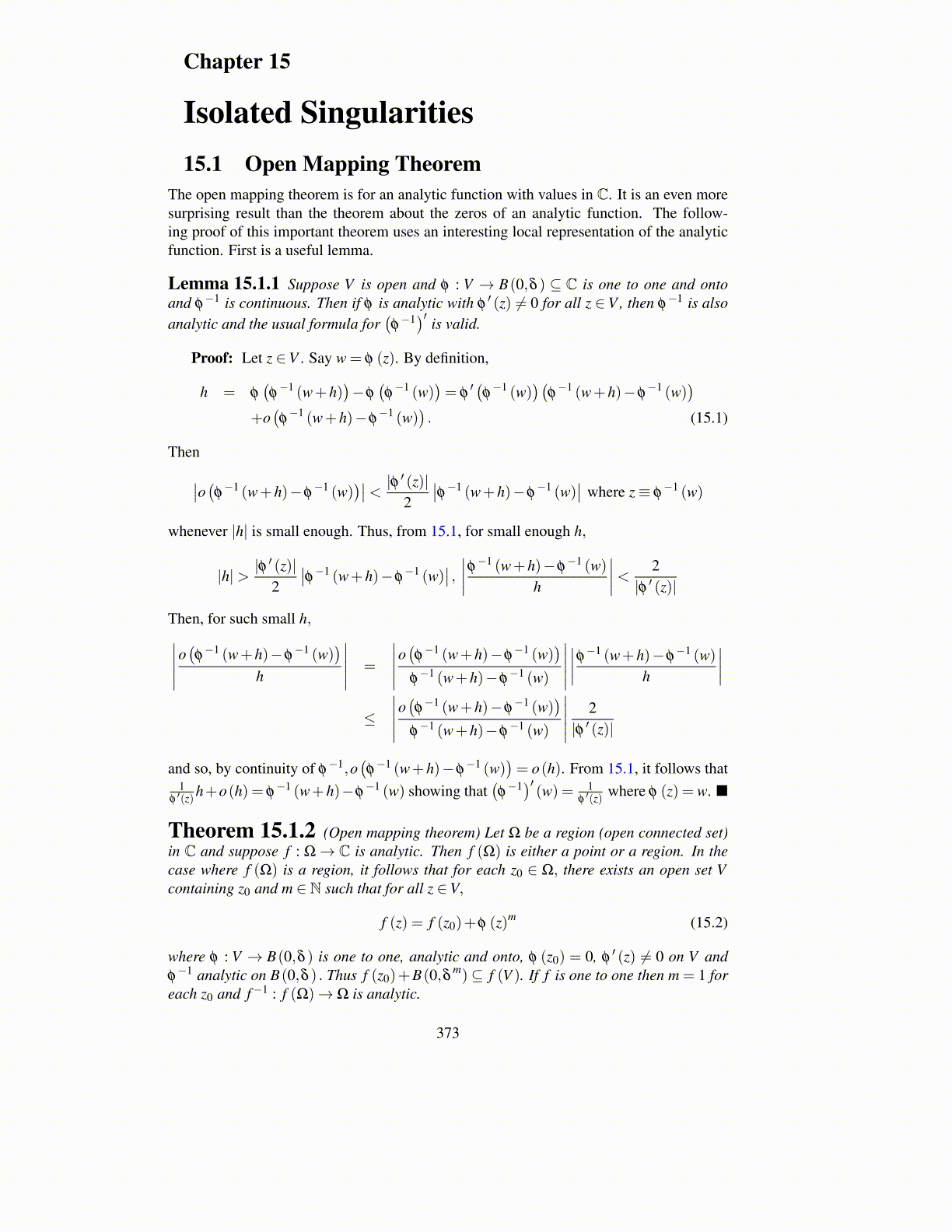
Chapter 15
Isolated Singularities15.1 Open Mapping Theorem
The open mapping theorem is for an analytic function with values in C. It is an even moresurprising result than the theorem about the zeros of an analytic function. The follow-ing proof of this important theorem uses an interesting local representation of the analyticfunction. First is a useful lemma.
Lemma 15.1.1 Suppose V is open and φ : V → B(0,δ ) ⊆ C is one to one and ontoand φ
−1 is continuous. Then if φ is analytic with φ′ (z) ̸= 0 for all z ∈V , then φ
−1 is alsoanalytic and the usual formula for
(φ−1)′ is valid.
Proof: Let z ∈V . Say w = φ (z). By definition,
h = φ(φ−1 (w+h)
)−φ
(φ−1 (w)
)= φ
′ (φ−1 (w)
)(φ−1 (w+h)−φ
−1 (w))
+o(φ−1 (w+h)−φ
−1 (w)). (15.1)
Then∣∣o(φ−1 (w+h)−φ−1 (w)
)∣∣< |φ ′ (z)|2
∣∣φ−1 (w+h)−φ−1 (w)
∣∣ where z≡ φ−1 (w)
whenever |h| is small enough. Thus, from 15.1, for small enough h,
|h|> |φ′ (z)|2
∣∣φ−1 (w+h)−φ−1 (w)
∣∣ , ∣∣∣∣φ−1 (w+h)−φ−1 (w)
h
∣∣∣∣< 2|φ ′ (z)|
Then, for such small h,∣∣∣∣∣o(φ−1 (w+h)−φ
−1 (w))
h
∣∣∣∣∣ =
∣∣∣∣∣o(φ−1 (w+h)−φ
−1 (w))
φ−1 (w+h)−φ
−1 (w)
∣∣∣∣∣∣∣∣∣φ−1 (w+h)−φ
−1 (w)h
∣∣∣∣≤
∣∣∣∣∣o(φ−1 (w+h)−φ
−1 (w))
φ−1 (w+h)−φ
−1 (w)
∣∣∣∣∣ 2|φ ′ (z)|
and so, by continuity of φ−1,o
(φ−1 (w+h)−φ
−1 (w))= o(h). From 15.1, it follows that
1φ ′(z)h+o(h) = φ
−1 (w+h)−φ−1 (w) showing that
(φ−1)′ (w) = 1
φ ′(z) where φ (z) = w. ■
Theorem 15.1.2 (Open mapping theorem) Let Ω be a region (open connected set)in C and suppose f : Ω→ C is analytic. Then f (Ω) is either a point or a region. In thecase where f (Ω) is a region, it follows that for each z0 ∈ Ω, there exists an open set Vcontaining z0 and m ∈ N such that for all z ∈V,
f (z) = f (z0)+φ (z)m (15.2)
where φ : V → B(0,δ ) is one to one, analytic and onto, φ (z0) = 0, φ′ (z) ̸= 0 on V and
φ−1 analytic on B(0,δ ) . Thus f (z0)+B(0,δ m)⊆ f (V ). If f is one to one then m = 1 for
each z0 and f−1 : f (Ω)→Ω is analytic.
373